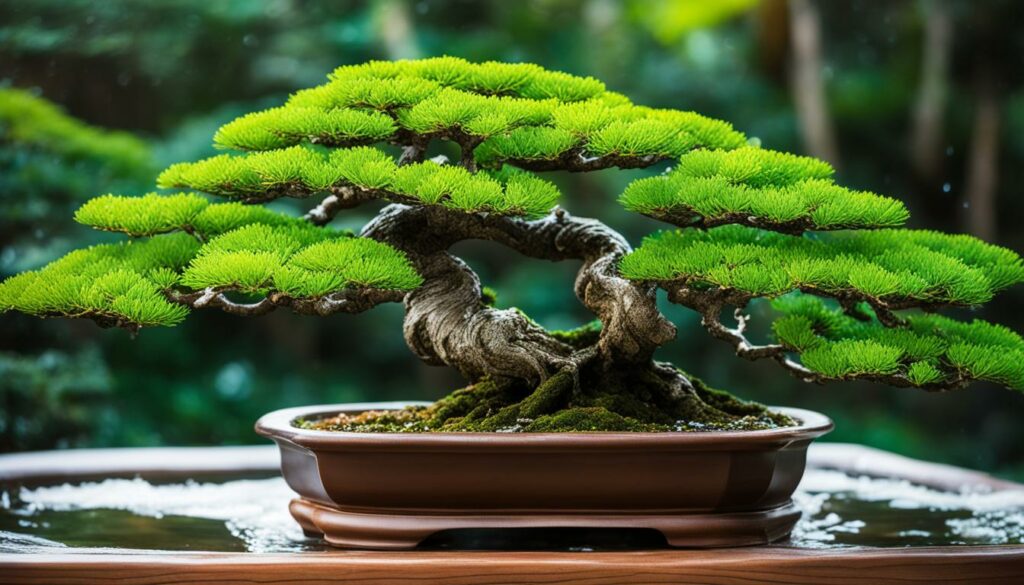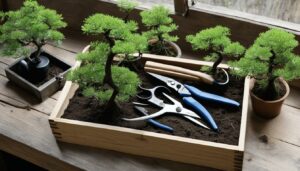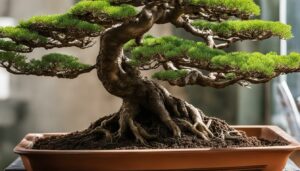As a dedicated bonsai enthusiast, you understand the nuances of Bonsai care and the dedication it takes to cultivate these miniature masterpieces. But have you considered the silent protagonist in the story of your bonsai’s health—the water you use? International Bonsai Magazine emphasizes how critical the role of water is, highlighting the water quality effects on nutrient absorption and the prevention of plant ailments. Heeding advice from the Bonsai Society of America, using water that boasts the right pH and mineral balance is not just beneficial, it’s essential for your bonsai to thrive. The Bonsai Network goes a step further, shedding light on the differences between various water sources and their direct impact on your bonsai’s vigor and wellness. To ensure you provide optimal bonsai hydration, it’s valuable to recognize how water quality can make or break your bonsai’s health.
Key Takeaways
- Recognize the importance of water quality in promoting healthy bonsai growth.
- Understand the consequences that impurities in water have on nutrient deficiencies and plant illnesses.
- Ensure the use of water with a proper pH and mineral balance for vitalizing your bonsai trees.
- Acknowledge that tap and rainwater can have varying effects on the health of your bonsai.
- Consistency in water source and quality is key to maintaining bonsai health.
Understanding Bonsai Water Requirements
Mastering the art of bonsai care is a nuanced journey, one that demands attention to the specific hydration needs of your miniature tree. Recognizing that each bonsai variety comes with its distinctive thirst, adapting a species-specific watering approach will not only enhance the vitality of your bonsai but also prevent common ailments associated with improper hydration.
Assessing Your Bonsai’s Specific Needs
The American Bonsai Society advocates for a customized approach to bonsai hydration, recognizing the diversity of water requirements across species. To ensure your bonsai receives the care it needs, it is crucial to assess factors such as the tree’s size, the pot’s volume, soil composition, and the environmental conditions—such as light exposure and local climate—that could influence your bonsai’s hydration needs.
| Bonsai Species | Water Frequency | Soil Moisture Level | Climate Considerations |
|---|---|---|---|
| Juniper | Every 1-2 days | Evenly moist, not soggy | Increases in hot or windy conditions |
| Ficus | Every 2-3 days | Allow to dry slightly between waterings | Less frequent in cooler, humid conditions |
| Pine | Every 2-4 days | Dry out more than deciduous trees | Dependent on season; less in winter |
| Maple | Every 1-2 days | Consistently moist | May require shade to avoid excessive drying |
The Role of Consistency in Watering Schedule
Adhering to a consistent schedule enables you as the caretaker to become attuned to your bonsai’s unique rhythms and adjust your watering practices accordingly. Bonsai Hobbyists Quarterly shares success stories of enthusiasts who have witnessed remarkable improvements in their bonsai’s growth and overall health by maintaining a disciplined watering schedule tailored to their specific plant’s needs.
Remember, your bonsai’s hydration needs are as unique as the tree itself. By assessing the individual needs and maintaining a consistent watering regime, you ensure your bonsai thrives, bringing peace and beauty to your environment.
Signs of Poor Water Quality in Bonsai Trees
As a bonsai enthusiast, it’s vital to stay vigilant for signs that could indicate the water you’re using is not meeting the needs of your miniature trees. Let’s delve into some of the most common symptoms of poor water quality and understand how they can manifest in your bonsai’s health.
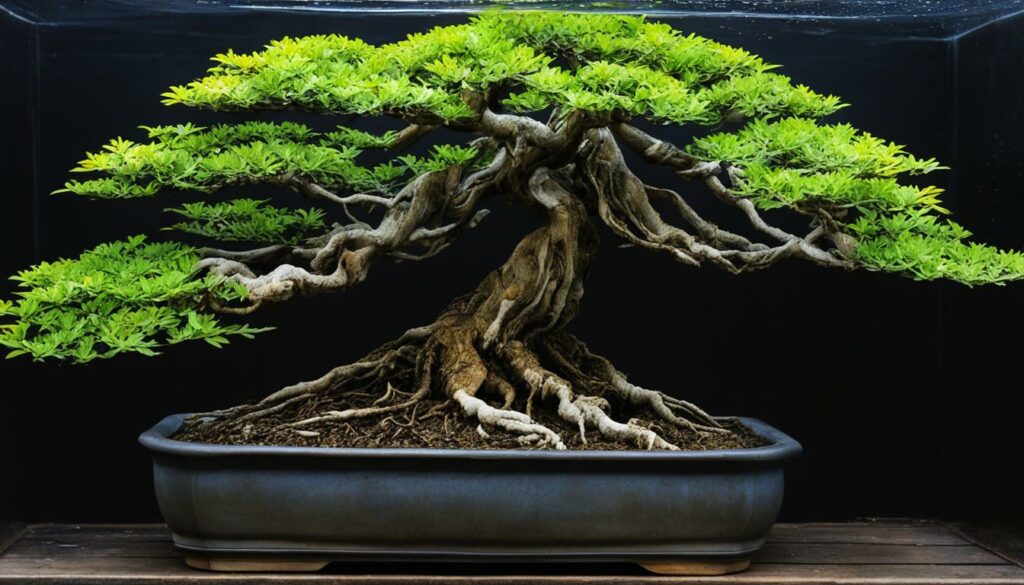
Yellowing or Dropping Leaves
One of the most conspicuous signs of distress in a bonsai is leaf yellowing or leaves that begin to drop prematurely. These symptoms can stem from a range of factors, but when linked to water quality, they often point to a possible mineral imbalance or a deficiency caused by inadequate nutrient uptake. If you’ve noticed such changes in your bonsai, it’s time to assess the water you’re providing.
Stunted Growth and Lack of Vigor
If your bonsai is displaying stunted growth or a noticeable lack of vigor, the quality of water could be a contributing factor. Impurities in water can lead to a build-up of harmful elements in the soil, which in turn may impede your bonsai’s ability to thrive and reach its full potential. Addressing these growth issues promptly can help restore your bonsai’s vitality.
| Symptom | Possible Water Quality Issue | Action to Take |
|---|---|---|
| Yellowing leaves | High chlorine or fluoride levels | Use filtered or rainwater |
| Dropping leaves | pH imbalance | Test water pH and adjust accordingly |
| Stunted growth | Excess salts or heavy metals | Flush the soil with clean water periodically |
| Lack of vigor | Insufficient nutrients | Reassess fertilization regimen |
Recognizing unhealthy bonsai signs early on is critical in mitigating the impact of poor water quality. By paying close attention to leaf yellowing and growth issues, you can take informed steps to ensure your bonsai remains a thriving and enchanting element of your home or garden.
Essential Water Quality Parameters for Bonsai
Meticulous attention to the water you provide your bonsai trees can make a significant difference in their health and growth. Understanding key parameters such as water pH, mineral content, and hardness levels is crucial. These factors greatly influence nutrient availability and soil structure, which are integral to the flourishing of bonsai trees.
The Significance of Water pH Levels
Water pH importance cannot be overstated when it comes to bonsai care. The pH level of your water affects how plants absorb nutrients. Most bonsai species thrive in slightly acidic to neutral pH range. It is vital to test your water’s pH and adjust it to meet the needs of your particular bonsai to ensure optimal nutrient uptake.
Understanding Mineral Content and Hardness
The mineral content in water contributes to the overall hardness. Water with high mineral content, or ‘hard water’, can lead to mineral deposits in the soil, which might block the roots from absorbing water and nutrients efficiently. Balancing these hardness levels is a key step in creating the perfect environment for your bonsai trees.
To better grasp how water quality affects your bonsai, here is an insightful table breaking down the ideal parameters for water pH, mineral content, and hardness:
| Parameter | Ideal Range | Impact on Bonsai |
|---|---|---|
| Water pH Level | 5.5 – 7.0 | Ensures optimal nutrient absorption |
| Mineral Content | Low to moderate | Prevents toxicity and allows for proper growth |
| Hardness Level (ppm CaCO3) | Reduces soil compaction and improves root health |
It is important to routinely check these parameters to maintain the health of your bonsai. Making necessary adjustments to your watering practice, like filtering hard water or adding natural acidifiers to increase acidity, could lead to a noticeable improvement in your bonsai’s vitality.
How Tap Water Can Affect Bonsai Health
Your bonsai is not just a plant; it’s a miniature ecosystem that depends on a delicate balance of elements to thrive. In this, the quality of the water you use is paramount. There are often hidden culprits in tap water—namely, chlorine and fluoride—that can have a profound impact on the health of your bonsai trees.
Chlorine and Fluoride: Common Tap Water Additives
Chlorine is commonly used in municipal water systems to kill harmful bacteria, but it can be too harsh for sensitive bonsai roots and may impede their ability to absorb nutrients effectively. Fluoride, while beneficial for human dental health, can accumulate in bonsai soil over time, potentially leading to toxicity issues. Acknowledging the chlorine effects on bonsai and the presence of fluoride in tap water is crucial for any bonsai enthusiast.
Strategies to Neutralize Damaging Elements in Tap Water
Fortunately, there are several strategies you can employ to neutralize these water additives, ensuring that your bonsai receives the clean, balanced hydration it needs. Let’s explore some recommended measures.
| Method | Benefits | Considerations |
|---|---|---|
| Water Filtration System | Removes chlorine, fluoride, and other impurities | Initial cost and filter replacements |
| Standing Tap Water | Allows chlorine to evaporate naturally | Does not remove fluoride; requires planning |
| Chemical Neutralizers | Specifically designed to neutralize chlorine | Chemicals must be dosed accurately; still may not address fluoride |
| Activated Carbon | Filters out a wide range of impurities | Needs regular replacement to remain effective |
| Reverse Osmosis | Highly effective at removing all contaminants | Requires significant water for the process; higher cost |
| Rainwater Collection | Natural and soft without additives | Dependent on weather; may require a storage system |
By incorporating tactics to manage chlorine effects on bonsai and the presence of fluoride in tap water, your bonsai can enjoy a refreshing, pure environment conducive to growth. It is also valuable to consider the use of neutralizing water additives when you cannot alter the source water. Balance is key, and by taking these steps, you can foster a healthier life for your cherished trees.
The Benefits of Rainwater for Bonsai Trees
Embracing the advantages of rainwater can drastically improve your bonsai care routine, providing natural hydration tailored to the needs of these delicate miniature trees. Experts from Bonsai Water Wisdom have long touted rainwater as the ideal solution for bonsai enthusiasts, due to its soft and slightly acidic nature which aligns perfectly with the hydration needs of most bonsai species.
According to Bonsai Sustainability Reports, using rainwater isn’t just beneficial for your bonsai; it also carries considerable environmental benefits. Harvesting rainwater reduces reliance on processed municipal water and helps in conserving this vital resource. Moreover, for bonsai trees that thrive with a certain pH level and mineral content, rainwater can be an excellent watering option, normally free of the additives found in tap water.
Setting up a rainwater harvesting system for your bonsai is not only effective but also straightforward. Rainwater Harvesting for Bonsai provides practical tips that enable you to collect and store rainwater efficiently. Whether you have a large garden or a small balcony, there’s a rainwater collection method that can fit your space and your tree’s needs.
| Advantage | Description | Impact on Bonsai Care |
|---|---|---|
| Soft Water Quality | Rainwater is naturally soft, free from the salts, minerals, and chemicals found in municipal water. | Prevents the buildup of harmful salts in the bonsai’s soil, promoting healthier growth. |
| Acidic pH | Rainwater typically has a slightly acidic pH, which can help maintain the desired soil pH balance. | Enhances nutrient availability and uptake, crucial for bonsai tree vigor. |
| Eco-Friendly | Collecting rainwater is a sustainable practice that reduces your environmental footprint. | Contributes to sustainable bonsai cultivation and aligns with eco-conscious gardening principles. |
| Ease of Collection | Rainwater can be easily collected through simple setups, even in urban areas. | Makes the practice of watering bonsai accessible and manageable regardless of your living situation. |
Take the opportunity to integrate rainwater into your bonsai hydration routine and notice the difference it makes. The transition from tap to rainwater could be the key to unlocking your bonsai’s full potential.
Bonsai Water Quality: Fine-Tuning for Perfect Balance
Keeping your bonsai healthy and thriving requires paying close attention to the water you provide. Like fine-tuning an instrument, achieving the perfect balance of pH levels and essential mineral balance in your bonsai’s water can make all the difference. This vital aspect of bonsai care ensures that your tree absorbs nutrients effectively and displays vibrant foliage.
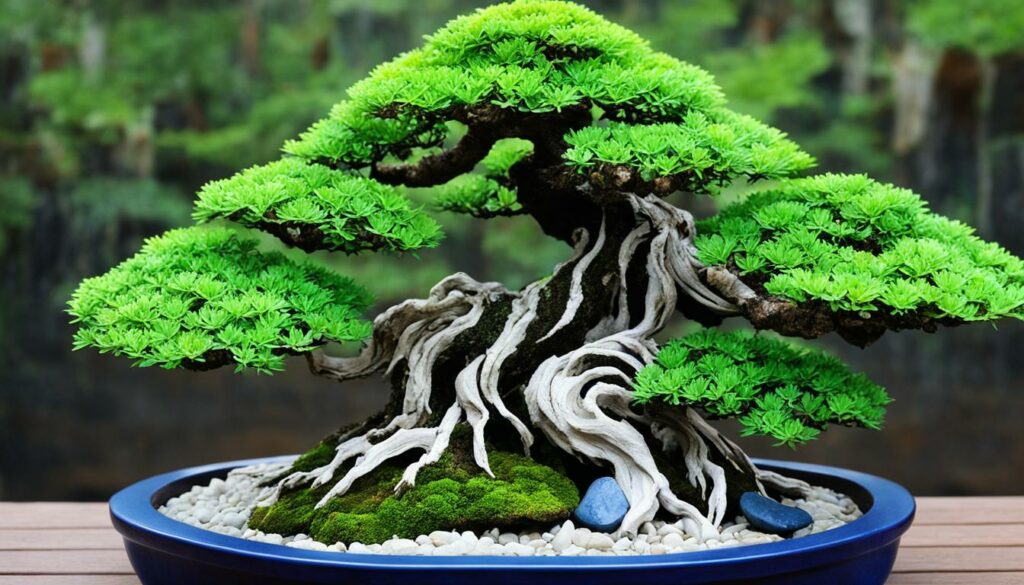
Adjusting pH Levels for Optimal Bonsai Health
To commence pH adjustment for bonsai, you’ll need to test the water regularly. Typically, bonsai trees flourish in a slightly acidic environment with a pH ranging from 5.5 to 6.5. If you discover that your water’s pH level is outside this range, there are ways to adjust it. For instance, adding natural ingredients like sulfur or peat moss can lower the pH, while lime can be utilized to raise it. Consistent monitoring will help you maintain the ideal pH and ensure your bonsai’s health is not compromised.
Identifying the Right Mineral Mix
When considering essential mineral balance, it’s important to comprehend which minerals are beneficial for your bonsai. Essential minerals such as nitrogen, phosphorus, and potassium support healthy growth, while calcium and magnesium contribute to robust cell structure. However, excess of certain minerals like sodium and chloride can be detrimental, leading to toxicity. Use a comprehensive testing kit to analyze the mineral content of your water and make necessary adjustments. Depending on your findings, you might need to filter your water or add specific amendments to achieve the perfect mineral harmony.
| Mineral | Benefit to Bonsai | Sources | Recommended Levels |
|---|---|---|---|
| Nitrogen (N) | Leaf and stem growth | Fish emulsion, compost tea | Low to moderate |
| Phosphorus (P) | Root and flower development | Bone meal, rock phosphate | Moderate |
| Potassium (K) | Overall plant health | Potash, wood ash | Moderate to high |
| Calcium (Ca) | Cell strength and growth | Gypsum, eggshells | Low |
| Magnesium (Mg) | Chlorophyll production | Epsom salts, dolomite lime | Low to moderate |
Water Filtration Options for Bonsai Enthusiasts
As a bonsai enthusiast, ensuring that your delicate trees receive the purest water is paramount. Exploring various water filtration solutions can significantly enhance your bonsai water filtration strategy. These solutions not only support the health of your bonsai but can also simplify your home water purification process.
Different Types of Water Filters
Whether you live in an urban setting or have access to natural water sources, a range of filters can cater to your needs:
- Activated Carbon Filters – Ideal for removing organic compounds and chlorine, thus improving both taste and smell of the water.
- Reverse Osmosis Systems – Although pricier, they are highly effective in eliminating a vast array of contaminants, offering near-pure water.
- Ceramic Filters – Economical and environmentally friendly, they can screen out bacteria and sediments without stripping away beneficial minerals.
DIY Techniques for Water Purification
For those who prefer a hands-on approach, engaging in DIY water treatment projects can be rewarding:
- Solar Water Disinfection – Utilize the power of the sun to neutralize pathogens in your water.
- Homemade Charcoal Filter – A fun project using natural materials that can reduce toxins in water.
- Sand and Gravel Filtration – Create a simple yet effective filtration system emulating natural purification processes.
Below is a comparison of commonly available water filtration options, to help guide your decision-making:
| Filter Type | Contaminants Removed | Maintenance | Approximate Cost |
|---|---|---|---|
| Activated Carbon | Chlorine, organic compounds, some metals | Regular cartridge replacement | $ |
| Reverse Osmosis | Salts, bacteria, viruses, heavy metals | Periodic membrane service | $$$ |
| Ceramic | Bacteria, sediments | Cleaning and occasional replacement | $ |
Embracing the right water filtration method can make a noticeable difference in your bonsai’s health and vitality. Keep in mind, the purity of water not only impacts your bonsai but also contributes to the sustainability of your home environment.
For those interested in environmentally friendly options, consider integrating green techniques into your water treatment plan. Simple changes, like collecting rainwater, can provide natural hydration suited to your bonsai’s needs. And as you become more adept at monitoring and modifying water quality, your bonsai will thrive, reflecting the care and dedication invested in their growth.
Seasonal Considerations in Bonsai Water Quality
As a bonsai enthusiast, you’re aware that each season brings its unique challenges and demands for bonsai care. Understanding how to adjust your watering techniques to accommodate seasonal bonsai care needs is crucial for maintaining the health and beauty of your miniature trees.
Summer Watering Strategies
During the hot summer months, your bonsai trees will require more frequent watering. The intense heat can quickly dry out the soil, so practicing diligent summer watering is imperative. You’ll need to monitor soil moisture closely and possibly water your bonsai once or even twice a day to ensure it stays hydrated. However, overwatering can be just as detrimental, so use a well-draining soil mix and containers with proper drainage holes to prevent waterlogged roots.
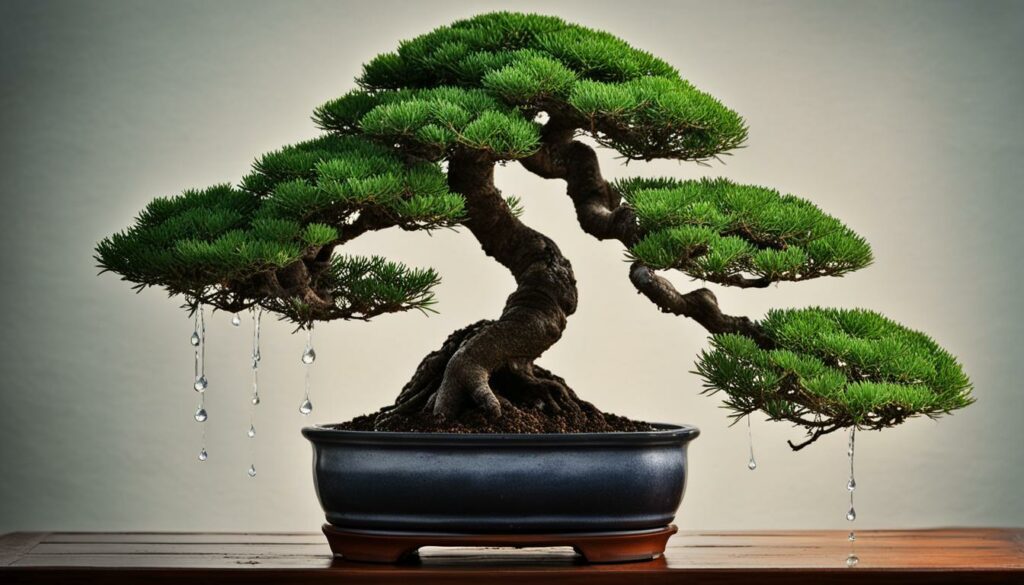
Winter Watering Adjustments
In contrast, during the colder winter months, your bonsai trees enter a dormancy period and their winter hydration needs decrease significantly. Watering too frequently can lead to root rot and other issues caused by excessive moisture in cold conditions. You should allow the soil to become slightly dry before watering and reduce the frequency. Additionally, pay attention to the water quality as colder temperatures can alter the chemical balance of your water source, affecting your bonsai’s health.
Maintaining the right water quality throughout the changing seasons will ensure that your bonsai trees not only survive but thrive. By implementing these tailored watering strategies, you will support the resilience and vitality of your bonsai collection all year round.
Testing Water Quality at Home for Bonsai Care
As a bonsai enthusiast, you understand that the health and beauty of your bonsai directly correlate with the quality of water you provide. Home water testing has become an essential practice in bonsai maintenance, allowing you to diagnose and react to any issues that could potentially harm your precious plants.
Simple Water Testing Kits
Gone are the days where you needed complex equipment or a chemistry degree to test your water quality. Today’s market offers a variety of simple, user-friendly water quality kits that can help you maintain the perfect environment for your bonsai. Brands like API and Tetra have created kits that test for key factors such as pH levels, chlorine content, hardness, and essential minerals, ensuring that even novice gardeners can assess their water.
Interpreting Test Results for Bonsai Maintenance
After utilizing water quality kits, deciphering the test results is your next step. Interpreting these results correctly can inform you about when to adjust your bonsai care regimen. If you’re new to test results interpretation, many kits come with comprehensive guides to aid your understanding. Otherwise, literature like the Bonsai Water Analysis Handbook can be a valuable resource in learning how to read and respond to different water quality indicators.
For your convenience, the table below summarizes common water quality parameters, their ideal ranges for bonsai care, and the implications of any deviations:
| Parameter | Ideal Range for Bonsai | Implications of Deviation |
|---|---|---|
| pH Level | 6.0 – 7.0 | Outside this range, nutrient uptake can be affected, potentially harming your bonsai’s health. |
| Chlorine Content | 0 ppm | High levels can cause leaf burn and damage delicate roots. |
| Total Hardness | Soft to Moderately Hard | Excessively hard water can lead to mineral buildup in soil, hindering growth. |
| Essential Minerals (e.g., Mg, Ca) | Varies | Imbalances can lead to nutrient deficiencies or toxicities. |
Equipping yourself with the right information through home water testing and result interpretation is a proactive step towards ensuring your bonsai trees thrive for years to come. Remember, the effort and attention you invest in bonsai care are reflected in the lush foliage and intricate beauty of your miniature trees.
Recognizing the Early Warning Signs of Water Toxicity
As you delve deeper into the world of bonsai care, it’s essential to remain vigilant about the health of your plant—a task that involves keeping an eye out for water toxicity indicators. Understanding these early warning signs can help prevent the damage caused by saline build-up and ensure the root health of your beloved bonsai. Let’s explore the symptoms to watch for and identify the respective measures you can take to safeguard your bonsai’s vitality.
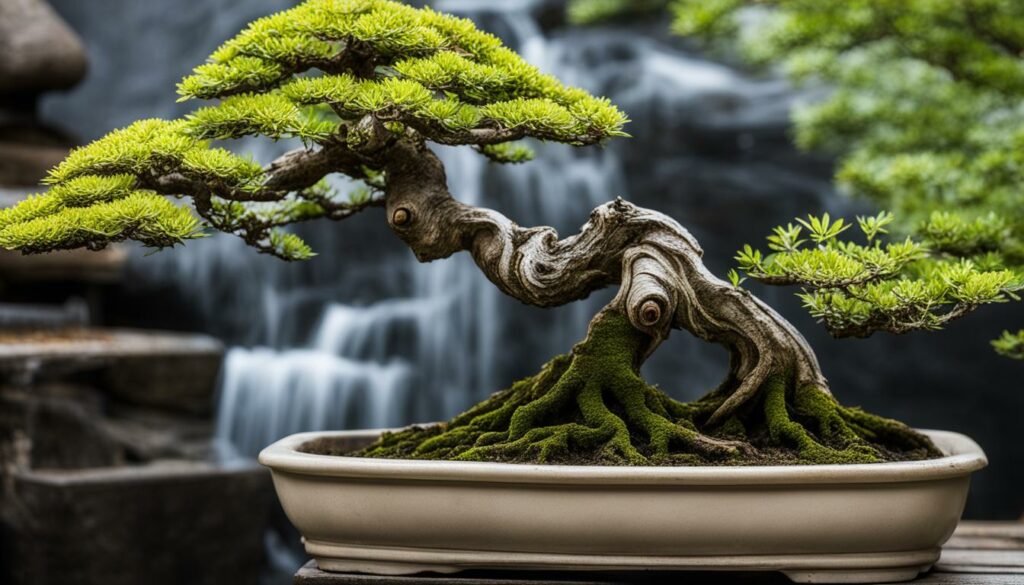
Visible Salt Deposits on Bonsai Soil
If you observe a white, crusty layer forming on the surface of your bonsai soil, it’s likely that you’re witnessing a saline build-up. These salt deposits, while common, can become toxic to your bonsai if left unchecked. They often result from the use of hard water or the overuse of fertilizers and can lead to nutrient imbalances within the soil.
Discoloration of Roots and Soil
Discoloration in the roots or soil of your bonsai can also be a telltale sign of water toxicity. Healthy roots should appear robust and light in color, while dark or brittle roots may suggest toxicity. Regularly inspecting the roots during repotting can help you catch these issues early, although visible changes in soil color can also indicate problems without the need for uprooting your plant.
| Indicator | Symptoms | Possible Causes | Action Steps |
|---|---|---|---|
| Saline Build-Up | White, crusty layer on soil surface | Hard water, excessive fertilizer use | Flush soil with distilled water, reduce fertilizer frequency |
| Root Discoloration | Dark, brittle roots | Poor drainage, contaminated water | Assess water source, improve soil aeration |
By staying attentive to these symptoms, you can take proactive steps to address water toxicity. Whether adjusting your watering practices, reevaluating your choice of water source, or modifying your fertilization routine, these actions will contribute significantly to the overall health and longevity of your bonsai tree.
The Use of Softened Water in Bonsai Cultivation
As a bonsai enthusiast, understanding the effects of softened water on your cherished trees is crucial for their health and vitality. Softened water use in bonsai cultivation has generated a nuanced dialogue among experts, considering its impact on bonsai soil interaction and nutrient absorption.
Pros and Cons of Softened Water for Bonsai
Softened water, while beneficial in preventing limescale in household piping, introduces a unique set of variables to bonsai maintenance. The process replaces calcium and magnesium with sodium, which can influence how bonsais access nutrients.
- Pros:
- Reduces soil alkalinity
- Prevents mineral buildup on leaves
- Diminishes water spotting on foliage
- Cons:
- Can lead to excess sodium in soil
- Potentially disrupts water and nutrient uptake
- May require additional nutrient supplementation
How Soft Water Interacts with Soil and Nutrients
The bonsai soil environment is complex, with softened water affecting its dynamics in multiple ways. Recognizing the bonsai soil interaction with softened water helps in calibrating your care strategy for optimal growth and nutrient uptake.
Water Softening Effects on Bonsai suggests that softened water can alter soil structure, impacting aeration and water retention. Conversely, Bonsai Soil Dynamics provides insight into softened water’s interactions with soil particles, potentially enhancing or impeding how bonsai roots absorb essential minerals.
| Soil Aspect | Impact of Softened Water |
|---|---|
| Soil pH Levels | May cause a decrease, affecting microorganism activity |
| Nutrient Availability | Sodium may compete with potassium, affecting nutrition |
| Soil Porosity | Sodium can cause clay particles to disperse, reducing porosity |
While softened water is often debated for its long-term use in bonsai cultivation, an informed balance could harness its benefits while mitigating risks. Investigate Trusted Bonsai Sources Annual to explore further into soft water practices that may best suit your bonsai’s unique requirements. A thoughtful approach to softened water use can lead to a thriving, lush bonsai display.
Impact of Local Water Sources on Bonsai Trees
As a Bonsai enthusiast, understanding local water quality variation is critical to the health and growth of your miniature trees. Varied sources can represent a kaleidoscope of mineral contents and pH levels, necessitating adaptable and informed regional watering practices to ensure bonsai vitality.
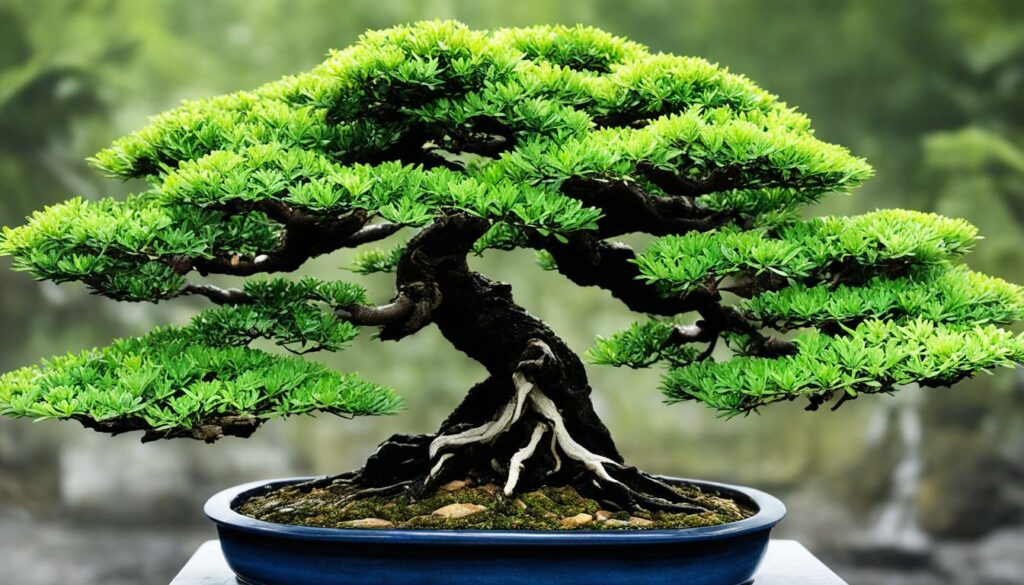
Understanding the Varied Quality of Regional Water
Through sources like Bonsai Across America, you will find that the quality of water can vary significantly from one region to another. This is due to a range of factors, including environmental conditions, treatment processes, and the presence of agricultural or industrial activities nearby. It’s these variations that can call for a tailored approach to bonsai care, ensuring that your precious plants get exactly what they need to thrive.
Adapting Bonsai Care to Your Local Water Conditions
Publications such as Urban Bonsai Gardening suggest that adapting bonsai care to local water conditions means you may need to invest in water testing kits or filters to ensure that municipal water supplies are on par with your bonsai’s needs. The National Bonsai Water Study further reinforces the need for such measures by offering insights into successful strategies employed by bonsai cultivators from differing locales, attuning their care to the rhythm of regional water dynamics.
By remaining observant and responsive to the signs of water incompatibility, you are better positioned to modify watering practices, perhaps even leaning into seasonal adjustments or the integration of collected rainwater, to give your bonsai the quality of water they deserve.
Conclusion
As we reach the end of our deep dive into the significance of water quality in bonsai care, it’s crucial to reflect on the key insights that have emerged. Water quality is not just another checkbox in the care routine of your bonsai; it’s the cornerstone of sustaining plant vitality. From the nuanced pH balance to the hidden dangers of chlorine and fluoride, every detail counts in crafting a conducive environment for your bonsai to thrive.
Key Takeaways on Bonsai Water Quality
A comprehensive bonsai water quality summary reveals that whether you’re drawing from the tap or collecting rainwater, attention to detail can make all the difference. Remember that the essence of bonsai care lies in mimicking the natural conditions as closely as possible, and the right water quality is integral to this process. Your dedication to assessing pH levels, understanding mineral content, and monitoring seasonal variations plays a pivotal role in maintaining bonsai vitality.
Continued Learning for Bonsai Health and Vitality
However, the quest for knowledge in bonsai cultivation doesn’t end here. Utilize the abundant learning resources available to you, from The Ultimate Guide to Bonsai Well-being to Lifelong Bonsai Cultivation, to stay abreast of the ever-evolving techniques and research. Participating in events like the Bonsai Mastery Seminar Series will not only expand your horizons but also connect you with a community of passionate growers who share your commitment to perfection. By continuously engaging with new information and refining your practices, you’ll be well-equipped to ensure that your bonsai trees remain a pinnacle of health and beauty.
FAQ
How does water quality affect bonsai tree health?
Water quality is crucial for bonsai health as impurities can lead to nutrient deficiencies and illnesses. Using water with the proper pH and mineral balance helps ensure that your bonsai trees flourish.
What specific water needs do different bonsai species have?
Each bonsai species has unique water requirements. It’s essential to determine these needs to tailor your watering approach, as outlined by the American Bonsai Society.
Why is having a consistent watering schedule important for bonsai trees?
A consistent watering schedule helps prevent stress and disease in bonsai trees. This routine is vital for maintaining the overall vigor and health of the plant.
What are some signs of poor water quality in bonsai trees?
Indicators of suboptimal water quality include yellowing or dropping leaves, which may suggest nutrient imbalances, and stunted growth, reflecting a lack of vigor.
Why are water pH levels significant for bonsai trees?
The pH levels of water affect nutrient uptake in bonsai trees. Ensuring the water pH is within the correct range for your bonsai species is critical for their health.
How does mineral content and hardness in water impact bonsai?
Mineral content and water hardness can affect the soil condition and plant health. It’s important to adjust these parameters to create an ideal environment for bonsai growth.
Can chlorine and fluoride in tap water harm bonsai trees?
Yes, chlorine and fluoride, commonly found in municipal tap water, can negatively impact bonsai trees. Neutralizing these elements through filtration or water treatments is recommended.
Are there benefits to using rainwater for bonsai irrigation?
Rainwater is beneficial for most bonsai trees as it is soft and slightly acidic, which is closer to the natural hydration conditions they would encounter in nature.
How can I fine-tune my bonsai’s water quality for the perfect balance?
To achieve the perfect water balance for your bonsai, you can adjust pH levels and identify the right mineral mix through testing and conditioning.
What are the different water filtration options available for bonsai enthusiasts?
Bonsai enthusiasts can choose from a variety of water filters, or even implement DIY water purification techniques to ensure optimal water quality.
Why should I consider seasonal changes in my bonsai watering strategy?
Seasonal variations in temperature and humidity affect your bonsai’s water needs. Adjusting your watering strategy accordingly helps maintain good health and vitality throughout the year.
How can I test water quality at home for bonsai care?
You can use simple water testing kits available on the market to test your water’s pH, mineral content, and hardness, which are essential for bonsai maintenance.
What are early warning signs of water toxicity in bonsai trees?
Early warning signs include visible salt deposits on the soil, which indicate excessive minerals, and discoloration of roots, which may signal water quality issues.
Is softened water good or bad for bonsai trees?
Softened water can have both pros and cons for bonsai trees. It may help by reducing mineral build-up, but an excessively soft water can potentially impact nutrient uptake negatively.
How should I adapt my bonsai care to the quality of local water sources?
Adapt your bonsai watering techniques based on regional water quality by testing the water and adjusting your regimen to match the specific needs of your bonsai species.
